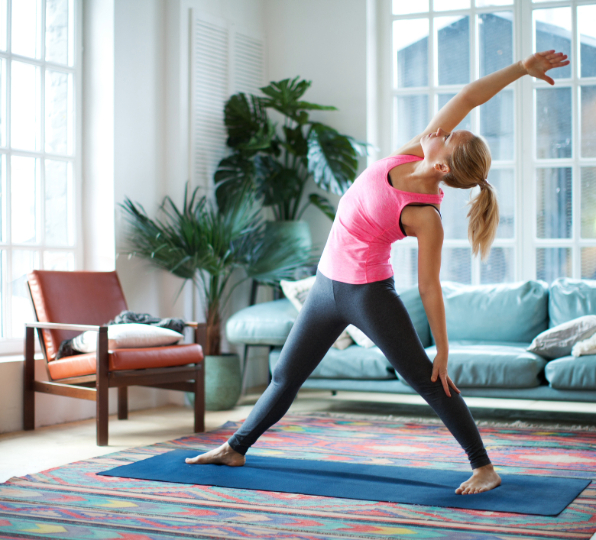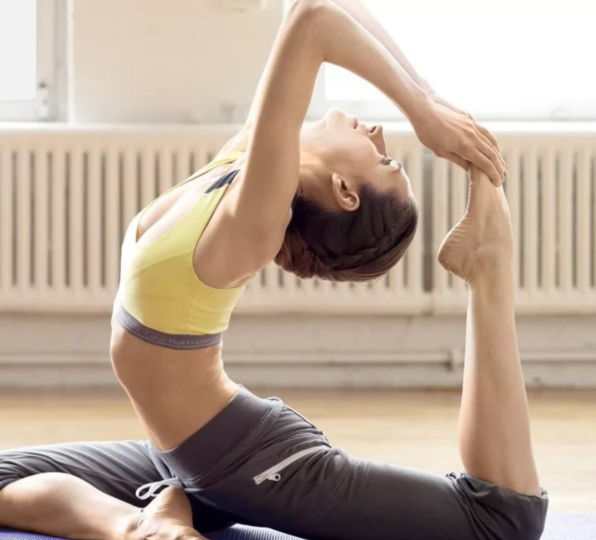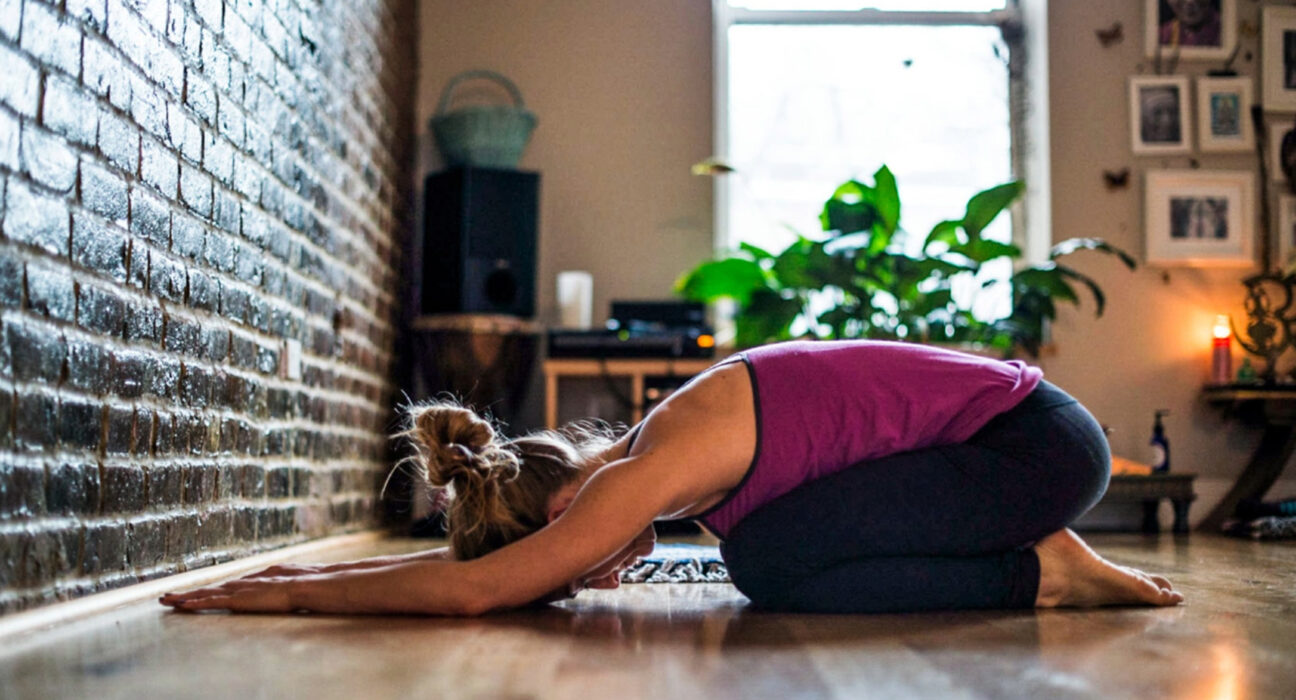Introduction:
A common sleep disorder called insomnia is characterized by trouble getting to sleep, remaining asleep, or waking up too early and feeling exhausted. In addition to promoting restful sleep, incorporating relaxation techniques like yoga into your bedtime routine can help manage insomnia, even with the assistance of medication and therapy. We’ll walk you through a gentle yoga practice in this blog post that’s meant to relax your body, quiet your mind, and get you ready for a good night’s sleep.
1. Child’s Pose
Child’s Pose, also known as Balasana in Sanskrit, is a gentle yoga pose that provides a sense of relaxation and release, making it an excellent choice for both beginners and experienced practitioners alike. This pose gently stretches the spine, hips, thighs, and ankles while promoting a sense of calm and tranquility in the mind and body. Here’s how to practice Child’s Pose:
- Begin on your hands and knees in a tabletop position, with your wrists aligned under your shoulders and your knees under your hips. Spread your fingers wide apart and press firmly into the mat to create a stable foundation.
- Slowly lower your hips back toward your heels, keeping your arms extended forward and your palms pressing into the mat. Your big toes should remain touching as you sit back between your heels.
- Separate your knees slightly wider than hip-width apart to create space for your torso to fit between your thighs. Allow your belly to soften and rest on your thighs, and let your forehead come to rest on the mat.
- Extend your arms forward, reaching them actively toward the top of your mat. Keep your elbows lifted slightly off the ground to avoid collapsing your chest, and actively press your palms into the mat to lengthen through your arms.
- Close your eyes and take deep, slow breaths as you settle into the pose. Allow your spine to lengthen with each inhale, and surrender any tension or tightness with each exhale. Focus on releasing any stress or tension in your back, shoulders, and hips.
- Hold the pose for 5-10 breaths, or longer if desired, allowing yourself to sink deeper into the stretch with each breath. Use this time to connect with your breath and cultivate a sense of inner calm and relaxation.
- To release the pose, gently press into your palms and slowly walk your hands back toward your body, lifting your torso upright. Come back to a comfortable seated position or transition into your next yoga pose.
Child’s Pose is a restorative and soothing pose that can be practiced at any time during your yoga practice or as a standalone pose to help alleviate stress and tension. It’s particularly beneficial for relieving lower back pain, opening the hips, and calming the mind after a long day. Incorporate Child’s Pose into your regular yoga routine to promote relaxation, flexibility, and overall well-being.
2. Legs-Up-the-Wall Pose
Legs-Up-the-Wall Pose, known as Viparita Karani in Sanskrit, is a restorative yoga pose that offers a myriad of benefits for both the body and mind. This gentle inversion involves lying on your back with your legs extended vertically up a wall, allowing gravity to assist in the relaxation of your lower body and the promotion of circulation. Here’s how to practice Legs-Up-the-Wall Pose:
- Find a clear wall space: Begin by finding a clear wall space where you can comfortably practice the pose. You may wish to place a yoga mat or blanket on the floor for added comfort and support.
- Sit close to the wall: Sit sideways with one hip close to the wall, ensuring that your body is perpendicular to the wall. Use your hands for support as you gently lower your back onto the floor and swing your legs up the wall.
- Extend your legs: Once your legs are extended vertically up the wall, allow your heels to gently rest against the wall. Your buttocks should be as close to the wall as feels comfortable, and your arms can rest by your sides with your palms facing up.
- Relax and breathe: Close your eyes and take slow, deep breaths as you settle into the pose. Allow your body to relax completely, releasing any tension or tightness in your muscles. Soften your facial muscles, jaw, and shoulders, and let go of any thoughts or distractions.
- Hold the pose: Remain in Legs-Up-the-Wall Pose for 5-10 minutes, or longer if desired. Allow gravity to gently stretch and release tension in your legs, hips, and lower back, while promoting circulation and drainage of excess fluid from the legs.
- Focus on your breath: Use this time to focus on your breath and cultivate a sense of inner calm and relaxation. Feel the gentle rise and fall of your belly with each inhale and exhale, and let go of any stress or tension with each breath.
- Release the pose: To come out of the pose, gently bend your knees and roll to one side, using your hands to support yourself as you come back to a seated position. Take a moment to pause and notice how you feel before slowly transitioning back to your day.
Legs-Up-the-Wall Pose is a deeply relaxing and rejuvenating pose that can help alleviate stress, improve circulation, and promote relaxation. Incorporate this gentle inversion into your yoga practice or daily routine to experience its many benefits for your body and mind.
3.Reclining Bound Angle Pose
Reclining Bound Angle Pose, or Supta Baddha Konasana in Sanskrit, is a restorative yoga pose that gently opens the hips and chest while promoting relaxation and a sense of ease in the body and mind. This pose is especially beneficial for relieving tension in the groin, hips, and lower back, making it an excellent choice for practitioners of all levels. Here’s how to practice Reclining Bound Angle Pose:
- Begin by lying on your back on a yoga mat or blanket. Bend your knees and bring the soles of your feet together, allowing your knees to fall open to the sides in a butterfly shape.
- Adjust your feet placement so that they are a comfortable distance away from your pelvis. You can choose to have your heels closer to your body for a deeper stretch or further away for less intensity.
- Let your arms rest by your sides with your palms facing up, or place your hands on your belly to connect with your breath and center yourself. Allow your shoulders to relax down away from your ears.
- Close your eyes and take slow, deep breaths as you settle into the pose. With each exhale, feel your body sinking into the mat and your hips gently opening. Relax any tension in your jaw, neck, and shoulders.
- Soften your gaze and bring your awareness to your breath, allowing it to flow naturally and effortlessly. Notice the expansion and contraction of your belly with each inhale and exhale.
- Hold the pose for 5-10 minutes, or longer if desired, allowing yourself to surrender fully to the support of the ground beneath you. Feel a gentle opening in your hips, groin, and chest with each breath.
- To release the pose, gently bring your knees together and hug them into your chest. You can rock from side to side to massage your lower back before slowly rolling onto one side and coming up to a seated position.
Reclining Bound Angle Pose is a deeply nurturing and restorative pose that invites a sense of surrender and relaxation. Incorporate this pose into your yoga practice to release tension in the hips and lower back, promote flexibility, and cultivate a deep sense of peace and well-being.
4.Seated Forward Bend
Seated Forward Bend, known as Paschimottanasana in Sanskrit, is a classic yoga pose that provides a deep stretch for the entire back of the body, including the spine, hamstrings, and calves. This forward fold also offers a sense of calm and relaxation, making it an excellent posture for reducing stress and promoting a sense of inner peace. Here’s how to practice Seated Forward Bend:
- Begin by sitting on the mat with your legs extended in front of you. Sit up tall, lengthening your spine and lifting through the crown of your head. Flex your feet, engaging your leg muscles.
- Take a deep breath in to lengthen your spine even further, drawing your shoulders down away from your ears. Feel the sensation of sitting up tall and grounded through your sit bones.
- On an exhale, begin to hinge forward at the hips, leading with your chest. Keep your back straight as you fold forward, avoiding any rounding or collapsing in the spine. Imagine lengthening the front of your torso as you reach forward.
- Reach your hands forward toward your feet, ankles, or shins, depending on your flexibility. Avoid forcing yourself into a deep fold; instead, focus on maintaining length in the spine and folding forward gradually with each breath.
- Relax your neck and shoulders as you hold the pose, allowing your head to hang heavy. Keep your gaze soft and directed toward your legs or the floor in front of you.
- As you hold the pose, take slow, deep breaths, allowing each exhale to deepen your forward fold. Feel the stretch along the back of your legs, spine, and neck, but avoid any discomfort or pain.
- Hold Seated Forward Bend for 5-10 breaths, or longer if it feels comfortable for you. Allow yourself to surrender to the pose and let go of any tension or resistance in your body and mind.
- To release the pose, slowly engage your core muscles to lift your torso back up to a seated position. Take a moment to sit up tall and observe any sensations in your body before transitioning into your next pose.
Seated Forward Bend is a calming and introspective pose that offers numerous physical and mental benefits. Incorporate this posture into your yoga practice to release tension in the back body, improve flexibility, and promote relaxation and peace of mind.


Conclusion:
Practicing this restful yoga routine before bedtime can help calm your mind, relax your body, and prepare you for a restful night’s sleep. By incorporating gentle yoga poses and mindful breathing into your bedtime routine, you can promote relaxation, alleviate tension, and improve sleep quality. Experiment with different poses and techniques to find what works best for you, and make yoga a regular part of your nighttime ritual for better sleep and overall well-being.












